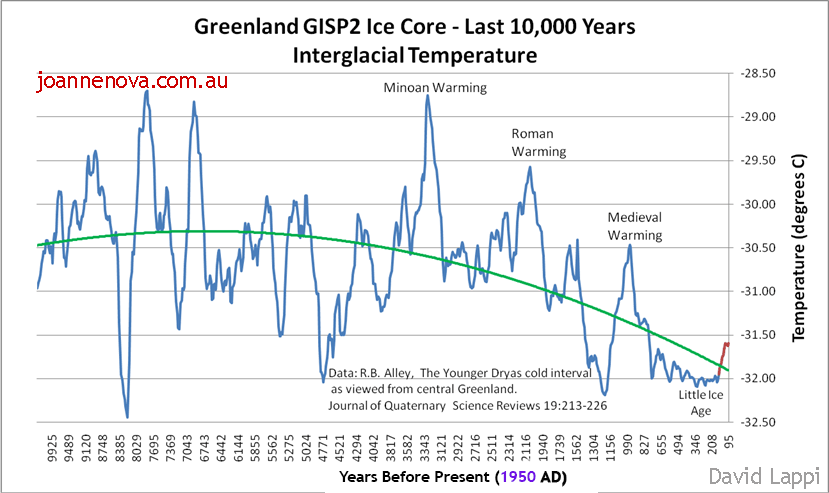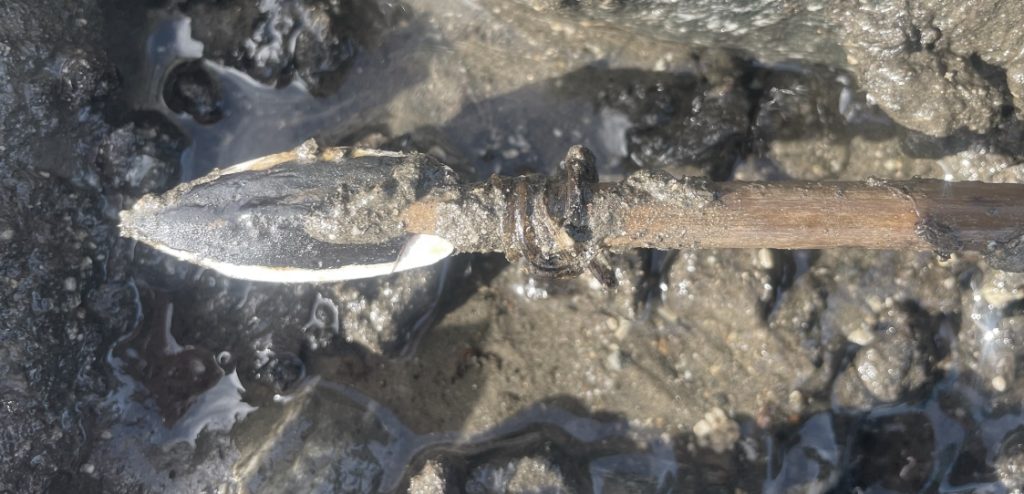By Jo Nova
It’s another outbreak of the Hottest-ever-Day Fever , where buses catch fire, and the worlds top journalists forget to ask anyone anything useful about the last 500 million years.

Sunday was the Worlds Hottest Day says the Guardian
The Copernicus data might be fine and dandy but it only goes back as far as 1979. The warm weather we are having now is just a welcome break in a cooling trend that started 7,000 years ago. It not only isn’t a record that means anything, it’s almost certainly a net benefit to warm blooded mammals.
The collective amnesia about the Holocene and most of the history of human civilization is complete. Apparently the world is in uncharted territory, except for thousands of rocks, stones, spears, shells, bits of wood, pollen, diatoms, fossilized plant leaves, and all the ice cores we’ve ever dug up. 4,000 stone-age spears and whatnot that melted out of the Norwegian glaciers in the last few years, must have frozen into them sometime in the last 5,000 years. And all the bones of dogs, rabbits, geese and frogs found inside the Arctic circle suggest our world is too brutally cold now. Likewise the giant oyster shell found on a building site in Taiwan reminds us of a time the oceans were 1 to 2 meters higher than today, and the cavemen survived just fine.
The planet saw its hottest day on record
CNN By Angela Fritz
Sunday was the hottest day in recorded history, according to preliminary data from a climate tracking agency monitoring temperatures since the mid-1900s.
It’s the second consecutive year average global temperatures have crashed through shocking climate records and will not be the last, as planet-warming fossil fuel pollution drives temperatures to shocking new highs.
July 21 clocked in at 17.09 degrees Celsius, or 62.76 Fahrenheit, and was the hottest day on Earth since at least 1940, according to the preliminary data from the European Union’s Copernicus Climate Change Service.
It’s 100,000 years of journalistic negligence:
Despite being based on data from the mid-20th century, the temperature records represent the warmest period the planet has seen in at least 100,000 years, scientists have found from many millennia of climate data extracted from ice cores and coral reefs.
Someone should send Angela Fritz (and most of the world’s journalists) the graphs of the ice cores which she has clearly never seen:

7,000 years of cooling in Greenland. This graph shows the ice-core data up until 1855. The last 150 years (1705 to 1855) are highlighted in red to show the warming as the Earth began coming out of the LIA.
Send them the Vostok Ice Cores too. Send them Brazilian sea levels, and tell them the the Sahara was lush green and wet, and the water near Indonesia was 2 degrees hotter. And 6,000 boreholes drilled around the world agree, along with 700 Pacific Islands that aren’t shrinking. The real science deniers are the ones ignoring half a billion years of evidence.
It’s been hotter for thousands of years during human civilization and it wasn’t caused by our cars.
REFERENCES
Copernicus media release –they it’s a the hottest day “in recent history” which the media turned into the hottest day in a hundred thousand years. h/t Gee Aye
Alley, R. B. (2000) The Younger Dryas cold interval as viewed from central Greenland. Quat. Sci. Rev. 19, 213-226
Aurélie Boilard et al, (2024) Ancient DNA and osteological analyses of a unique paleo-archive reveal Early Holocene faunal expansion into the Scandinavian Arctic, Science Advances . DOI: 10.1126/sciadv.adk3032
Fontes et al (2017) The Impacts of the Middle Holocene High Sea-Level Stand and Climatic Changes on Mangroves of the Jucuruçu River, Southern Bahia – Northeastern Brazil, Radiocarbon , Volume 59 , Issue 1 , February 2017 , pp. 215 – 230. DOI: https://doi.org/10.1017/RDC.2017.6
Huang, S. P., H. N. Pollack, and P.-Y. Shen (2008), A late Quaternary climate reconstruction based on borehole heat flux data, borehole temperature data, and the instrumental record, Geophys. Res. Lett., 35, L13703, doi:10.1029/2008GL034187 [PDF] Long blog discussion on boreholes.
Kench, P.S., Liang, C., Ford, M.R. et al. (2023) Reef islands have continually adjusted to environmental change over the past two millennia. Nat Commun 14, 508 doi.org/10.1038/s41467-023-36171-2
Lewis, S.E., et al., Post-glacial sea-level changes around the Australian margin: a review, Quaternary Science Reviews (2012), http://dx.doi.org/10.1016/j.quascirev.2012.09.006 [abstract]
Li H-C, Mii H-S, Liu T-K, et al. (2024) AMS 14C Dating and Stable Isotope Analysis on an 8 kyr Oyster Shell from Tapei Basin: Sea level and SST changes. Radiocarbon. Published online 2024:1-15. doi:10.1017/RDC.2023.117
Hamish McGowan,Samuel Marx, Patrick Moss, Andrew Hammond (2012): Evidence of ENSO mega-drought triggered collapse of prehistory Aboriginal society in northwest Australia, Geophysical Research Letters, Vol 39, Issue 22. DOI: 10.1029/2012GL053916 [Abstract]
Rehn, E. et al (2021) A late-Holocene multiproxy fire record from a tropical savanna, eastern Arnhem Land, Northern Territory, Australia [PDF]
Rosenthal, Y., Braddock K. Linsley, Delia W. Oppo (2013) Pacific Ocean Heat Content During the Past 10,000 Years, Science 1 November,Vol. 342 no. 6158 pp. 617-621 DOI: 10.1126/science.1240837 [Sciencemag.org ]
Yacoub et al., (2023), The African Holocene Humid Period in the Tibesti mountains (central Sahara, Chad): Climate reconstruction inferred from fossil diatoms and their oxygen isotope composition
Kuper and Kropelin, (2006): Climate-controlled holocene occupation in the Sahara: motor of africa’s evolution. Science 313, 803e807. https://doi.org/10.1126/ science.1130989
